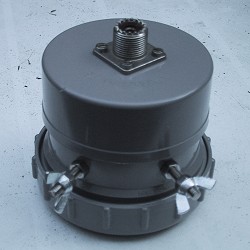HF 1:4 balun
Introduction
Some years ago a friend offered me an HF radio: an Icom IC-730. I decided to buy it, since I didn’t have a HF rig yet. I gave it a nice place on my shelf, connected some meters of wire on the antenna plug, and from that moment I sometimes listen to all kind of chirps and beeps. I recovered my Hamcomm modem to see some wxfax images and SSTV, I tried to follow CW QSO’s again, listened to some conversations in SSB, etc.
Although this is not bad at all, I wanted to participate again. Since I moved to Utrecht, my radio activity was very low. I didn’t have any antennas on the roof, which made it difficult to pick up this nice and interesting hobby again. But… after participating in the 2002 jamboree on the air I decided to revive my radio hobby. And since I moved back to the country late 2005, I had all opportunities to set up antenna’s.
The first HF antenna I wanted to build was a Windom Antenna. This antenna required a 1:4 balun, so I made one.
Construction
The balun can be made from a T200-2 core. In my design I used only 1, since the output of my rig is about 100W. However, when using more power just stack 2 cores, they will easily handle 400 watts. Now take 2 wires and twist them arround the core like shown on the picture down here.
That was the easy thing. Now you have to build a solid case. I found a simple solution, by using some 75mm PVC elements which are normally used for draining. One part is normally used to put in a T-junction and let you access the pipe. It has a screw top with rubber inside. The second is a simple end point to close a pipe. Both parts can be glued together (not yet, do it later) to form solid and dry case.
Next I drilled 2 holes in the part with the unscrewable top for 2 bolts (will be used for connection both wires of the dipole). I made some holes in the other part of the case to fit a PL chassis. The picture down here shows all the details. Notice the rubber rings to be sure that no rain water will pass through the holes. Don’t forget to mount a hook somewhere, you will need it when you hang the antenna.
![[image]](https://www.pa3hcm.nl/wp-content/uploads/2013/12/enh-logo1.jpg)


![[image]](https://www.pa3hcm.nl/wp-content/uploads/2005/12/hf-balun-case1.jpg)
![[image]](https://www.pa3hcm.nl/wp-content/uploads/2005/12/hf-balun-case3.png)